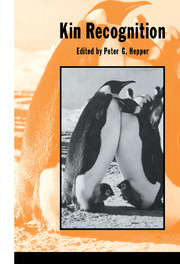Book contents
- Frontmatter
- Contents
- List of contributors
- Preface
- Introduction
- 1 The correlation between kinship and behaviour in non-human primates
- 2 Co-operation and reciprocity in birds and mammals
- 3 Kinship and fellowship in ants and social wasps
- 4 Successes and failures of parent–offspring recognition in animals
- 5 Kinship, kin discrimination and mate choice
- 6 Genetic components of kin recognition in mammals
- 7 Kin recognition in amphibians
- 8 Kin recognition cues of vertebrates
- 9 Recognizing kin: ontogeny and classification
- 10 Parental states as mechanisms for kinship recognition and deception about relatedness
- 11 Fetal learning: implications for the development of kin recognition
- 12 Information processing and storage during filial imprinting
- 13 The honey bee as a model kin recognition system
- 14 Mutual mother–infant recognition in humans
- Author index
- Species and common name index
- Subject index
11 - Fetal learning: implications for the development of kin recognition
Published online by Cambridge University Press: 06 January 2010
- Frontmatter
- Contents
- List of contributors
- Preface
- Introduction
- 1 The correlation between kinship and behaviour in non-human primates
- 2 Co-operation and reciprocity in birds and mammals
- 3 Kinship and fellowship in ants and social wasps
- 4 Successes and failures of parent–offspring recognition in animals
- 5 Kinship, kin discrimination and mate choice
- 6 Genetic components of kin recognition in mammals
- 7 Kin recognition in amphibians
- 8 Kin recognition cues of vertebrates
- 9 Recognizing kin: ontogeny and classification
- 10 Parental states as mechanisms for kinship recognition and deception about relatedness
- 11 Fetal learning: implications for the development of kin recognition
- 12 Information processing and storage during filial imprinting
- 13 The honey bee as a model kin recognition system
- 14 Mutual mother–infant recognition in humans
- Author index
- Species and common name index
- Subject index
Summary
Since Hamilton's oft-cited prediction regarding the unequal distribution of behaviour among genetically related (kin) and unrelated conspecifics (nonkin) (Hamilton, 1964), the phenomenon of kin recognition has been repeatedly documented among a diverse assortment of animal species (Colgan, 1983; Fletcher & Michener, 1987; this volume). As in other maturing fields of inquiry, attention has shifted from description and documentation of recognition systems to a search for the ‘mechanisms’ supporting kin recognition. This search has produced a canonical list that typically comprises four classes of mechanisms: (1) spatial distribution, (2) familiarity, (3) phenotype matching, and (4) recognition alleles. These hypotheses have been offered as explanations of the dynamic control of recognition, but generally contain reference to the developmental means by which recognition cues come to exert their effects (Hepper, 1986; Fletcher, 1987). Thus, the ontogeny of kin recognition has, explicitly or implicitly, become one of the central foci of debate in this relatively young field.
In nature, among species bearing multiple offspring in a single clutch or litter (including most mammals), a necessary concomitant to reproduction is the association of mother with offspring and of littermate siblings with one another. Therefore, some degree of prior experience with related conspecifics is virtually inevitable. A common experimental design intended to isolate effects of prior experience involves cross-fostering of some offspring to unrelated litters shortly after birth. However, even if performed within moments of birth, cross-fostering cannot separate genetic factors from experiences of siblings that share the same prenatal environment (cf. Ressler, 1962).
- Type
- Chapter
- Information
- Kin Recognition , pp. 308 - 334Publisher: Cambridge University PressPrint publication year: 1991
- 6
- Cited by



